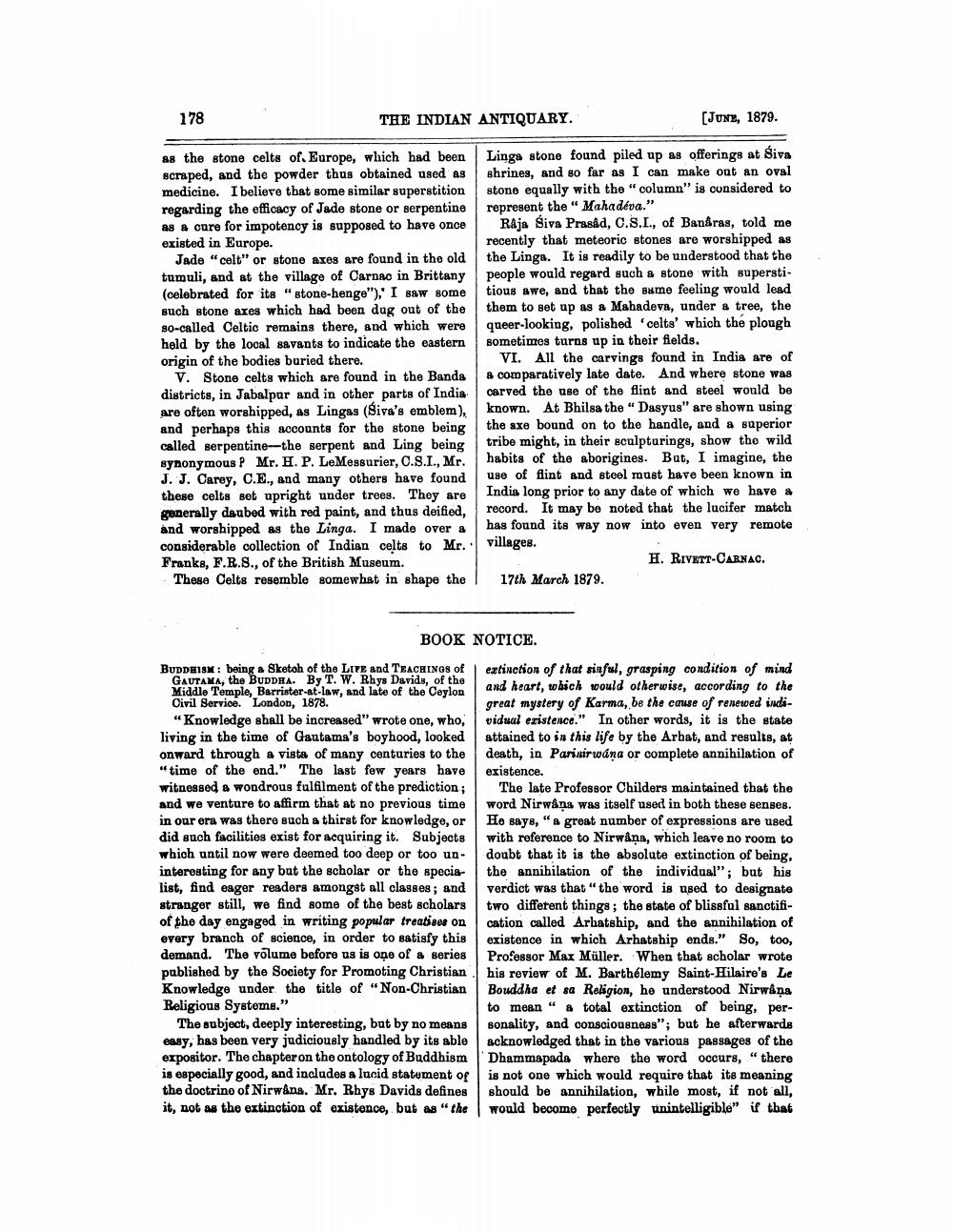________________
178
THE INDIAN ANTIQUARY.
as the stone celts of Europe, which had been scraped, and the powder thus obtained used as medicine. I believe that some similar superstition regarding the efficacy of Jade stone or serpentine as a cure for impotency is supposed to have once existed in Europe.
Jade "celt" or stone axes are found in the old tumuli, and at the village of Carnac in Brittany (celebrated for its "stone-henge")," I saw some such stone axes which had been dug out of the so-called Celtic remains there, and which were held by the local savants to indicate the eastern origin of the bodies buried there.
V. Stone celts which are found in the Banda districts, in Jabalpur and in other parts of India are often worshipped, as Lingas (Siva's emblem), and perhaps this accounts for the stone being called serpentine-the serpent and Ling being synonymous? Mr. H. P. LeMessurier, C.S.I., Mr. J. J. Carey, C.E., and many others have found these celts set upright under trees. They are generally daubed with red paint, and thus deified, and worshipped as the Linga. I made over a considerable collection of Indian celts to Mr. Franks, F.R.S., of the British Museum.
These Celts resemble somewhat in shape the
BOOK
BUDDHISM: being a Sketoh of the LIFE and TEACHINGS of GAUTAMA, the BUDDHA. By T. W. Rhys Davids, of the Middle Temple, Barrister-at-law, and late of the Ceylon Civil Service. London, 1878.
"Knowledge shall be increased" wrote one, who, living in the time of Gautama's boyhood, looked onward through a vista of many centuries to the "time of the end." The last few years have witnessed a wondrous fulfilment of the prediction; and we venture to affirm that at no previous time in our era was there such a thirst for knowledge, or did such facilities exist for acquiring it. Subjects which until now were deemed too deep or too uninteresting for any but the scholar or the specialist, find eager readers amongst all classes; and stranger still, we find some of the best scholars of the day engaged in writing popular treatises on every branch of science, in order to satisfy this demand. The volume before us is one of a series published by the Society for Promoting Christian Knowledge under the title of "Non-Christian Religious Systems."
The subject, deeply interesting, but by no means easy, has been very judiciously handled by its able expositor. The chapter on the ontology of Buddhism is especially good, and includes a lucid statement of the doctrine of Nirwana. Mr. Rhys Davids defines it, not as the extinction of existence, but as "the
[JUNE, 1879.
Linga stone found piled up as offerings at Siva shrines, and so far as I can make out an oval stone equally with the "column" is considered to represent the "Mahadeva."
Raja Siva Prasad, C.S.I., of Banaras, told me recently that meteoric stones are worshipped as the Linga. It is readily to be understood that the people would regard such a stone with superstitious awe, and that the same feeling would lead them to set up as a Mahadeva, under a tree, the queer-looking, polished 'celts' which the plough sometimes turns up in their fields.
VI. All the carvings found in India are of a comparatively late date. And where stone was carved the use of the flint and steel would be known. At Bhilsa the "Dasyus" are shown using the axe bound on to the handle, and a superior tribe might, in their sculpturings, show the wild habits of the aborigines. But, I imagine, the use of flint and steel must have been known in India long prior to any date of which we have a record. It may be noted that the lucifer match has found its way now into even very remote villages. H. RIVETT-CARNAC.
17th March 1879.
NOTICE.
extinction of that sinful, grasping condition of mind and heart, which would otherwise, according to the great mystery of Karma, be the cause of renewed individual existence." In other words, it is the state attained to in this life by the Arbat, and results, at death, in Parinirwana or complete annihilation of existence.
The late Professor Childers maintained that the word Nirwana was itself used in both these senses. He says, "a great number of expressions are used with reference to Nirwana, which leave no room to doubt that it is the absolute extinction of being, the annihilation of the individual"; but his verdict was that "the word is used to designate two different things; the state of blissful sanctification called Arhatship, and the annihilation of existence in which Arhatship ends." So, too, Professor Max Müller. When that scholar wrote his review of M. Barthélemy Saint-Hilaire's Le Bouddha et sa Religion, he understood Nirwana to mean " a total extinction of being, personality, and consciousness"; but he afterwards acknowledged that in the various passages of the Dhammapada where the word occurs, "there is not one which would require that its meaning should be annihilation, while most, if not all, would become perfectly unintelligible" if that




